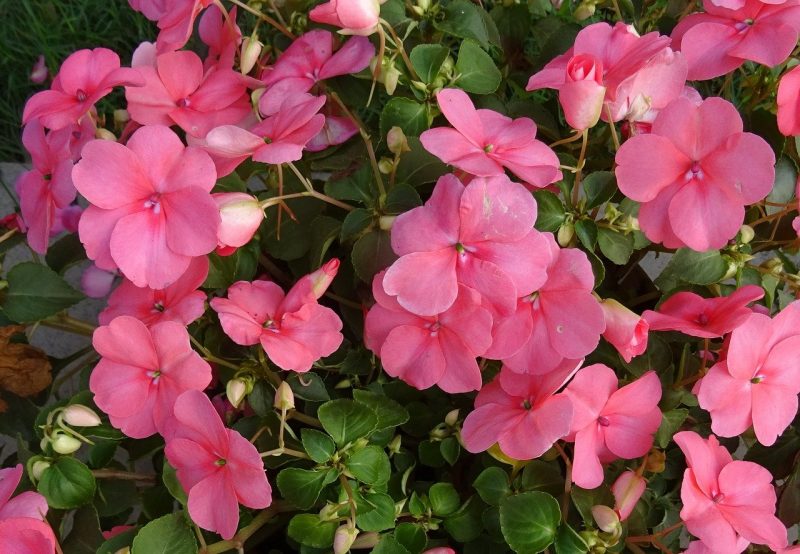Impatiens are no-fuss plants, but when problems do develop, it pays to know how to revive dying impatiens. When wilting and other start issues occur, taking preventive measures and knowing the most common problems that affect impatiens can help save your dying plants.
Here’s a quick guide on how to revive dying impatiens based on the symptoms that develop:

Nematodes: Stunted Plants, Yellow Leaves, and/or Root Lesions
Nematodes or roundworms sometimes attack impatiens. It’s hard to spot nematodes because they’re very small and they’re usually buried deep within the soil. These worms have pierce-sucking mouths that can affect your impatiens, causing them to get sickly, stunted, and wilted. You’ll start to notice that the leaves will turn yellow and the roots won’t grow properly.
The effects of nematodes are more noticeable in hot weather. It’s twice as hard for nematode-affected plants to recover from the midday heat and will start to wilt when evening comes. Remove severely infected impatiens, along with the soil around the roots. You can repel nematode attacks by fertilizing your plants with fish emulsion mixed with water and pour it on the soil.
Excessive Heat Dryness: No Flowers and/or Wilting
Too much heat can cause your plants to wilt and stop blooming. Be sure to keep watering so they’ll bloom again when the temperature drops. It also helps to use organic mulch to keep the soil cooler and encourages the flowers to bloom.
Wilting can also be a sign that your plants are exposed to too much sun. If this is the case, water your plants well. Younger plants can be transplanted to a location with more shade.
Bacterial Wilt: Rotting Stems at the Soil Line and Sudden Wilting
Bacterial diseases can cause rotting stems and sudden wilting. As a result, your impatiens plants will die and collapse. A yellowish substance (the bacteria) will ooze out of the stems if you cut them.
Remove the infected plants from the roots along with garden debris. Disinfect the tools that you use in a solution with hot water and bleach or spray disinfectant spray on them. Don’t plant your impatiens with other plants vulnerable to bacterial wilts, such as eggplants, potatoes, and tomatoes.
Overfeeding: Excessive Leaves and Fewer Blooms
You don’t need to fertilize impatiens regularly, but when you do overfeed them and give them too much nitrogen in a single feeding, your impatiens will focus all their energy to produce leaves. This gives them less energy to produce more flowers. The tender foliage is more susceptible to aphid infestation and other harmful insects. If you’re going to feed your impatiens, use a slow-acting, granular fertilizer instead.
Tarnished Plant Bug: Dwarfed or Deformed Flowers
A tarnished plant bug is a green or brown colored insect that sucks the life of younger impatiens, resulting in deformed or dwarfed blooms. These bugs are about a quarter-inch big with yellow, brown, and black marks. You’ll usually find yellow triangles with black tips on the sides. Tarnished plant bugs usually appear early in the spring season and they’ll multiply when summer ends.
If you can spot them early, you can handpick them and place them in a jar of soapy water. For major tarnished plant bug infestations, use pyrethrin/pyrethrum insecticides and spray them early in the morning because the bugs are less active during the day. Be sure to clean your garden during the fall and spring season to keep these bugs from overwintering.
Why You Should Grow Your Impatiens in a Semi Pro Greenhouse
There are several advantages to growing your impatiens in a semi pro greenhouse, such as:
Protecting your plants from pests
Aphids, tarnished plant bugs, and other harmful pests may feed on the leaves and flowers of your plants. Keeping your impatiens inside a semi pro greenhouse lowers the risk of infestation, as well as the development of diseases.
Great for gardeners who want to grow flowers but have limited space
Growing impatiens in a semi pro greenhouse is great for homeowners with limited garden space. With a standard size of feet, you can plant anything you want and place the greenhouse on your balconies, decks, and patios.
Start plant growth early
With a semi pro greenhouse, you can start planting even before the warm or cold season begins in your area. You can keep them safe inside the greenhouse and take them out once the weather becomes more tolerable.
Keep them safe from bad weather
Semi pro greenhouses can also shield your plants from unpredictable weather. Snow, ice, or frost can kill even the hardiest plants, so place your impatiens in a greenhouse and wait until the weather becomes friendlier before taking them out or you can grow them inside until maturity.
Final Thoughts on How to Revive Dying Impatiens
Wilting is one of the most common signs that there’s something wrong with your impatiens. Water stress and heat stress can also cause flowers and leaves to drop. You should keep the soil consistently moist but not completely drenched. If they’re exposed to too much sun, transfer your plants to a shadier location.
Now that you know what to look for and how to revive dying impatiens, you’ll be able to enjoy beautiful blooms throughout the growing season.
